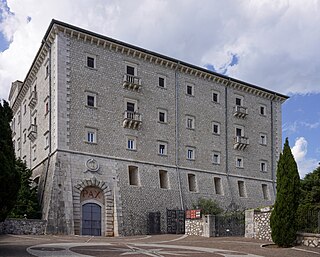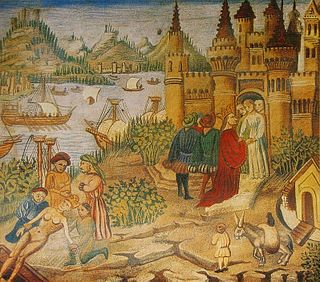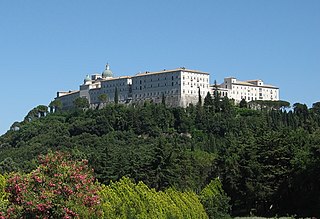Pope Stephen IX was the head of the Catholic Church and ruler of the Papal States from 3 August 1057 to his death in 29 March 1058. He was a member of the Ardenne-Verdun family, who ruled the Duchy of Lorraine, and started his ecclesiastical career as a canon in Liège. He was invited to Rome by Pope Leo IX, who made him chancellor in 1051 and one of three legates to Constantinople in 1054. The failure of their negotiations with Patriarch Michael I Cerularius of Constantinople and Archbishop Leo of Ohrid led to the permanent East–West Schism. He continued as chancellor to the next pope, Victor II, and was elected abbot of the Benedictine monastery of Montecassino.

Pope Victor III, was the head of the Catholic Church and ruler of the Papal States from 24 May 1086 to his death. He was the successor of Pope Gregory VII, yet his pontificate is far less notable than his time as Desiderius, the great abbot of Montecassino.

Monte Cassino is a rocky hill about 130 kilometres (80 mi) southeast of Rome, in the Latin Valley, Italy, 2 kilometres west of Cassino and at an elevation of 520 m (1,710 ft). Site of the Roman town of Casinum, it is widely known for its abbey, the first house of the Benedictine Order, having been established by Benedict of Nursia himself around 529. It was for the community of Monte Cassino that the Rule of Saint Benedict was composed.

Robert "Guiscard" de Hauteville, sometimes Robert "the Guiscard", also nicknamed “Terror Mundi”, was a Norman adventurer remembered for his conquest of southern Italy and Sicily in the 11th century.

The Schola Medica Salernitana was a medieval medical school, the first and most important of its kind. Situated on the Tyrrhenian Sea in the south Italian city of Salerno, it was founded in the 9th century and rose to prominence in the 10th century, becoming the most important source of medical knowledge in Western Europe at the time.
Sikelgaita was a Lombard princess, the daughter of Prince Guaimar IV of Salerno and second wife of Duke Robert Guiscard of Apulia. She commanded troops in her own right.

Amatus of Montecassino, was a Benedictine monk of the Abbey of Montecassino who is best known for his historical chronicles of his era. His History of the Normans, is one of three principle primary sources for the Norman Conquest of southern Italy--the other two being the histories of William of Apulia and Geoffrey Malaterra. Amatus describes the Normans from the perspective of his abbey, one of the most important religious and cultural centers in Italy at the time. His history is the earliest extant account of the Norman sieges of Bari and Salerno, their conquest of Sicily, and the careers of both Robert Guiscard and Richard Drengot, as well as the Gregorian Reforms seen from the papal point of view.
Richard Drengot was the count of Aversa (1049–1078), prince of Capua and duke of Gaeta (1064–1078).

Jordan I, count of Aversa and prince of Capua from 1078 to his death, was the eldest son and successor of Prince Richard I of Capua and Fressenda, a daughter of Tancred of Hauteville and his second wife, also named Fressenda, and the nephew of Robert Guiscard, duke of Apulia, Calabria, and Sicily. He, according to William of Apulia, "equalled in his virtues both the duke and his father."

Gisulf II was the last Lombard prince of Salerno (1052–1077).
William of Hauteville was one of the younger sons of Tancred of Hauteville by his second wife Fressenda. He is usually called Willermus instead of Wilelmus in Latin annals and so is often called Guillerm instead of Guillaume in French.
Alfanus of Camerota was the Archbishop of Capua from 1158 until his death around 1180. He was a very close friend to Pope Alexander III.

The Norman conquest of southern Italy lasted from 999 to 1139, involving many battles and independent conquerors.
Alfanus, Alphanus or Alfano may refer to:
Alfanus II or Alfano II was the Archbishop of Salerno from 1086/7 until his death, succeeding Alfanus I. Like his predecessor and his successor, Romuald I, he was a Lombard.

The 1086 papal election ended with the election of Desiderius, abbot of Monte Cassino as Pope Gregory VII's successor after a year-long period of sede vacante.
Ranulf I was the count of Caiazzo in the Principality of Capua from about 1078. He also brought the formerly Lombard counties of Alife, Telese and Sant'Agata dei Goti and the castles of Airola and Tocco Caudio under his control, dominating the region between Capua and Benevento. He passed this territorial lordship on intact to his heirs, and it remained in their possession until the death of his grandson and namesake, Ranulf II, in 1139.
The Roman Catholic Diocese of Pesto was a bishopric, later under the name of Capaccio, and became a Latin Catholic titular see in 1966.
Pandulf III was briefly the Prince of Salerno from around 3 to 10 June 1052. He was the eldest of four brothers of Gemma, wife of Prince Guaimar IV. He seized the throne in a coup d'état, when he and his brother assassinated Guaimar. He reigned for only a week before he was forced to step down and was promptly murdered.

Helena, born Olympias, was a daughter of the Norman duke of Apulia, Robert Guiscard, and the Lombard noblewoman Sikelgaita. From 1074 until 1078, she was the fiancée of the Byzantine co-emperor Constantine Doukas.









